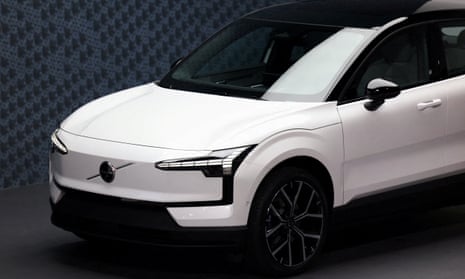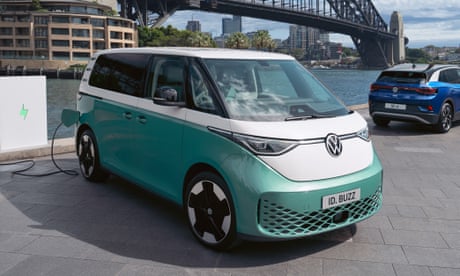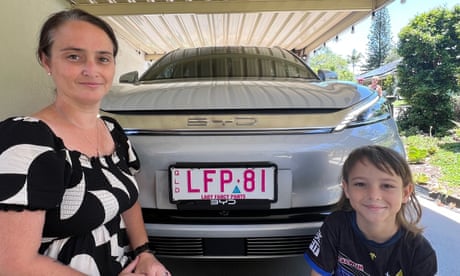
EV sales are booming and longtime favourite makes and models are being ignored in favour of Tesla and BYD.
Fri 12 Jan 2024 01.00 AEDT
Last modified on Fri 12 Jan 2024 07.10 AEDTThe top three selling electric vehicles in Australia in 2023 were from Tesla and BYD, between them accounting for two-thirds of the 87,217 electric cars sold, according to figures released by the Federal Chamber of Automotive Industries.
Of the top 10 selling EVs, only two mainstream brands – MG and Kia – had cars on the leader board, with the likes of Toyota, Mazda, Hyundai and Nissan nowhere to be seen.
And prestige and luxury brands accounted for 70% of EV sales, with Volvo (35.5% of its sales being EV), Mercedes-Benz (13.1%), BMW (11.4%), Mini (12.9%) and Porsche (8.8%) above the industry average of 7.2% EV penetration.
A surprising 36% of all prestige and luxury cars are now powered by electricity, although the figure is dragged up by EV-only brands such as Tesla and Polestar.
In contrast, EVs from the top six selling brands in the country – Toyota, Mazda, Ford, Kia, Hyundai and Mitsubishi – accounted for a combined 6% of the electric car market; between them the sextet sold 617,582 cars in 2023 – more than half the entire new vehicle market that achieved a record 1,216,780 sales – but just 5,581 were EVs.
It’s indicative of a two-speed electric car market that is seeing mainstream brands finding their feet and dedicated EV brands and luxury marques fighting for a sizeable slice of the market.
More to the story
The headline figures showing 7.2% of the 1,216,780 vehicles sold in 2023 were powered solely by electricity don’t tell the whole story.
That is because many market segments have no or minimal EV offerings.
Many commercial vehicle segments, for example, do without a viable electric vehicle offering.
Delve into the passenger car and SUV figures, though, and there is a healthier EV story bubbling away.
The Tesla Model 3 is the top-selling sedan in the country, for example, easily outselling the once-dominant Toyota Camry that is tens of thousands of dollars cheaper.
The circa-$65,000 sedan has single-handedly breathed life into the medium four-door market in Australia that many brands have abandoned.
Add in the rival Polestar 2 and Hyundai Ioniq 6 and electric cars accounted for 62% of all medium cars priced above $60,000, shading former market leaders from Mercedes-Benz, BMW and Audi.
Include mainstream models such as the Camry and EVs are approaching half the medium segment, at 42%.
The middle ground
It is a similar story with mid-sized SUVs, where the Tesla Model Y dominated 20-odd rivals by commanding a 44% slice of the $60,000-plus SUV segment.
It also almost beat the popular Toyota RAV4 in a race to become the top selling SUV.
As it stood almost one in six of the 268,480 medium SUVs bought in Australia throughout 2023 were powered only by electrons.
And there’s more to come in 2024.
Within weeks Subaru and Toyota will start selling electric-only SUVs – the first battery electric vehicle for each brand in Australia – although high prices are likely to keep sales modest.
Toyota is forecasting it will only sell 1,500 of its bZ4X – which is expected to be priced north of $70,000 – in the first 12 months. Tesla sells that many Model Ys in about 19 days.
“We want to bring a car to market that’s suitable for our buyers, takes the risk out of the buyer equation and gives them a damn happy experience,” says Sean Hanley, Toyota Australia vice-president of sales, marketing and franchise operations.
He argues EVs are better suited to city driving.
Towards the middle of the year there will also be electric mid-sized SUVs from Volkswagen, Skoda, Nissan and Audi, as well as the BYD Seal U, Kia EV5 and Polestar 4.
Later this year Porsche will stop producing petrol versions of its top selling vehicle, the Macan SUV, and replace them with an all-electric new generation car.
It is a bold move from a brand with a rich history in high octane performance but is indicative of a fast-changing market.
Small EV impact yields big results
There’s also EV action heating up in the hatchback market courtesy of the late-year arrival of three circa-$40,000 contenders: MG4, BYD Dolphin and GWM Ora.
Between the trio they accounted for more than 1,000 sales a month in the final quarter of 2023.
It meant those three EVs – each sourced from China – stole 14% of the small hatch/sedan market that includes big players such as the Toyota Corolla, Hyundai i30, Mazda3 and Kia Cerato.
It is a remarkable achievement given the relative lack of brand recognition.
Canberra doing the EV heavy lifting
The nation’s political heartland loves EVs, according to the sales figures.
Whereas the national average EV take-up is 7.2%, in the Australian Capital Territory it surged to 18.3%.
Only one state – NSW – was above the national average, with 7.7% of all vehicles sold an EV.
Perhaps unsurprisingly the Northern Territory had the lowest EV uptake, at just 2.7%.
And despite trouncing eastern states in its shift to renewables only 5.5% of new cars sold in South Australian took advantage of that cleaner electricity.
Last year also gave an insight into the impact rebates and incentives can have on EV take-up.
Midyear Victoria shelved its $3,000 electric car rebate almost a year earlier than planned and it saw sales drop.
In the first half of the year 7.5% of vehicles sold in Victoria were electric, whereas in the second half that dropped to 6.1%.
And in the few weeks Victorians had to snap up the last of the rebates before they ended on 30 June, EV sales soared: 16.1% of all EVs sold in Victoria in 2023 were bought in June, whereas the rest of the country was at 11.5%.


No comments:
Post a Comment